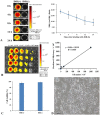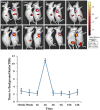DiR-labeled Embryonic Stem Cells for Targeted Imaging of in vivo Gastric Cancer Cells
- PMID: 22768029
- PMCID: PMC3388594
- DOI: 10.7150/thno.4561
DiR-labeled Embryonic Stem Cells for Targeted Imaging of in vivo Gastric Cancer Cells
Abstract
Embryonic stem (ES) cells have great potential in applications such as disease modeling, pharmacological screening and stem cell therapies. Up to date, there is no related report on the use of ES cells as tracking and contrast reagents of cancer cells in vivo. Herein we report that DiR-labeled murine ES cells can recognize and target gastric cancer cells in vivo. DiR-labeled murine ES (mES) cells (5×10(6)) were intravenously injected into gastric tumor-bearing mice. The biodistribution of DiR-labeled mES cells was monitored by IVIS imaging within 24 h. Major organs were harvested and analyzed by immunofluorescence staining and Western blotting. Chemotaxis assay was employed to investigate the chemotaxis of ES cells tracking cancer cells. Fluorescent imaging results showed that DiR-labeled mES cells targeted gastric cancer tissue in vivo as early as 10 min post-injection, reaching a peak at 2h post-injection. Immunofluorescence staining and Western blotting results showed gastric cancer tissues specifically expressed SSEA-1. In vitro migration tests confirmed that mES cells actively moved to test sites with different concentration of CXCL12 in a dose-dependent manner. In conclusion, DiR-labeled mES cells may be used for gastric cancer targeted imaging in vivo, and have great potential in applications such as identifying and imaging of early gastric cancer in near future.
Keywords: chemotaxis.; gastric cancer cells; migration; murine embryonic stem cells; target imaging.
Conflict of interest statement
Competing Interests: The authors have declared that no competing interest exists.
Figures






Similar articles
-
Fluorescent magnetic nanoparticle-labeled mesenchymal stem cells for targeted imaging and hyperthermia therapy of in vivo gastric cancer.Nanoscale Res Lett. 2012 Jun 18;7(1):309. doi: 10.1186/1556-276X-7-309. Nanoscale Res Lett. 2012. PMID: 22709686 Free PMC article.
-
Assessment of endothelial colony forming cells delivery routes in a murine model of critical limb threatening ischemia using an optimized cell tracking approach.Stem Cell Res Ther. 2022 Jun 21;13(1):266. doi: 10.1186/s13287-022-02943-8. Stem Cell Res Ther. 2022. PMID: 35729651 Free PMC article.
-
Live cell imaging of highly activated natural killer cells against human hepatocellular carcinoma in vivo.Cytotherapy. 2021 Sep;23(9):799-809. doi: 10.1016/j.jcyt.2020.11.004. Epub 2021 Jun 24. Cytotherapy. 2021. PMID: 34176769
-
Dynamic tracking of stem cells in an acute liver failure model.World J Gastroenterol. 2012 Feb 14;18(6):507-16. doi: 10.3748/wjg.v18.i6.507. World J Gastroenterol. 2012. PMID: 22363116 Free PMC article.
-
In vivo Near-infrared Fluorescence Tumor Imaging Using DiR-loaded Nanocarriers.Curr Drug Deliv. 2016;13(1):40-8. doi: 10.2174/1567201812666150703114908. Curr Drug Deliv. 2016. PMID: 26138681 Review.
Cited by
-
Identification of volatile biomarkers of gastric cancer cells and ultrasensitive electrochemical detection based on sensing interface of Au-Ag alloy coated MWCNTs.Theranostics. 2014 Jan 5;4(2):154-62. doi: 10.7150/thno.7560. eCollection 2014. Theranostics. 2014. PMID: 24465273 Free PMC article.
-
Bright Polymer Dots Tracking Stem Cell Engraftment and Migration to Injured Mouse Liver.Theranostics. 2017 Apr 10;7(7):1820-1834. doi: 10.7150/thno.18614. eCollection 2017. Theranostics. 2017. PMID: 28638470 Free PMC article.
-
Practical Issues with the Use of Stem Cells for Cancer Gene Therapy.Stem Cell Rev Rep. 2015 Oct;11(5):688-98. doi: 10.1007/s12015-015-9605-9. Stem Cell Rev Rep. 2015. PMID: 26123358 Free PMC article. Review.
-
Bone Marrow Stromal Cells Alleviate Secondary Damage in the Substantia Nigra After Focal Cerebral Infarction in Rats.Front Cell Neurosci. 2019 Jul 24;13:338. doi: 10.3389/fncel.2019.00338. eCollection 2019. Front Cell Neurosci. 2019. PMID: 31396057 Free PMC article.
-
Seeing stem cells at work in vivo.Stem Cell Rev Rep. 2014 Feb;10(1):127-44. doi: 10.1007/s12015-013-9468-x. Stem Cell Rev Rep. 2014. PMID: 23975604 Free PMC article. Review.
References
-
- Reubinoff BE, Pera MF, Fong CY. et al. Embryonic stem cell lines from human blastocysts: somatic differentiation in vitro. Nature Biotechnology. 2000;18:399–404. - PubMed
-
- Hoehn M, Kustermann E, Blunk J. et al. Monitoring of implanted stem cell migration in vivo: a highly resolved in vivo magnetic resonance imaging investigation of experimental stroke in rat. Proceedings of the National Academy of Sciences of the United States of America. 2002;99:16267–72. - PMC - PubMed
-
- Lapidot T. Mechanism of human stem cell migration and repopulation of NOD/SCID and B2mnull NOD/SCID mice. Annals of the New York Academy of Sciences. 2001;938:83–95. - PubMed
LinkOut - more resources
Full Text Sources
Other Literature Sources
Miscellaneous

